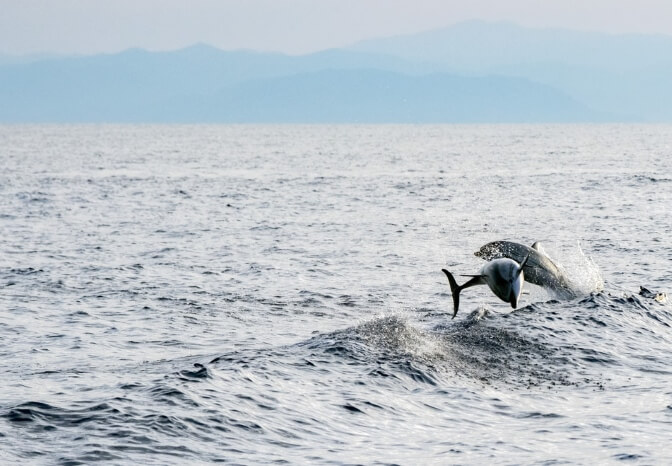Did you know that P&O Ferries routes are regularly used by Research Surveyors for MARINElife, a charity that keeps records of sightings to aid marine management and conservation? In fact, the group’s first outings started on a former P&O ferry service that ran from the UK to Bilbao.
We spoke to Emma Neave-Webb, Vice-Chair of Trustee Board at MARINElife, who has been spotting marine wildlife on our ferry routes for several years. Read on to hear about some of her favourite on-board experiences, as well as her top tips for anyone hoping to spot some fantastic creatures for themselves on their next crossing.

P&O: What’s it like to go out looking for marine wildlife on a ferry?
Emma Neave-Webb: “We’re really lucky here in the UK to have some amazing wildlife living in or visiting our seas regularly. For MARINElife, heading out to complete surveys on ferries is really important as it allows us a cheap, reliable and regular way to get out and gather data on the state of marine wildlife. I always love travelling by ferry and get really excited about the possibilities of what I might see.”
P&O: What’s the purpose of the records that you create on these crossings?
ENW: “Our surveys are dedicated effort surveys run on a monthly basis by trained volunteers to record whales, dolphins and porpoises as well as seabirds. Through these projects and collaborations with like-minded organisations, we aim to further the conservation of the wildlife of oceans and coasts through scientific investigation and educational activities.

“By using ferries, we’re able to collect information on the distribution of both cetaceans and sea birds, which helps managers and policy makers make important and informed decisions about marine management and conservation. This work also helps to raise awareness of an aspect of our seas that few people appreciate – we have a fantastic selection of whales, dolphins and seabirds in our waters that some people might assume you have to travel abroad to see!”
P&O: What’s been your favourite spotting/moment while you were out?
ENW: “I spent four years working as a Wildlife Officer on the ex-P&O Ferry Pride of Bilbao which sailed to Northern Spain. During that time, I had some amazing encounters and my most memorable is difficult to choose.

“It’s between being interrupted during a deckwatch by a pod of around 25 orca breaching beside the ship, passing through a superpod of over 4000 striped dolphin (there were dolphins in all directions as far as the eye could see!) or holding the record for the highest number of fin whale (the second largest animal in the world) in one afternoon of 196 individual animals. What an amazing sight!”
Emma’s top tips for spotting marine wildlife on your ferry crossing
“Wrap up warm (it can be surprisingly nippy on deck), grab a cup of coffee and be patient. It can sometimes take a long time to spot anything and I can guarantee that something will pop up the minute you walk away! It used to happen to me all the time.

“Don’t be disheartened if you don’t spot anything first time out; it does take practice and experience to spot dolphins or porpoises sometimes. And most importantly: don’t forget your binoculars!”
Marine wildlife spotted by MARINElife on our ferry routes
MARINElife volunteers regularly travel on our ferry routes across the English Channel (Dover to Calais), the North Sea (Hull to Zeebrugge or Rotterdam) and the Irish Sea (Liverpool to Dublin). Here are just some of the incredible marine wildlife they’ve spotted on their trips:
Harbour porpoise

The world population of harbour porpoises is estimated to be around 700,000, with half of these making their home in the North Sea. They’re a fairly common sighting on our Hull to Zeebrugge route, particularly in late summer, and near the port of Calais.
Bottlenose dolphin

The sociable bottlenose dolphin tends to appear in small groups, and sometimes alongside other species, such as the harbour porpoise. It’s regularly seen throughout the year in the outer Channel. Sightings have been recorded on all three of our routes used by MARINElife.
Grey Seal

Another common character across our routes, this protected species can be spotted either swimming or gathered along the coastline in small groups. Be sure to keep an extra keen eye out if your ferry is docking in Hull.
Atlantic Puffin

These spectacular birds are rarely seen at sea, though they breed in small colonies in the North Atlantic. There are recorded spottings on our Liverpool to Dublin and Hull to Zeebrugge routes.
Multiple species of whale

There are a number of species of whale that inhabit the seas around the UK and Ireland, with minke whale sightings particularly prevalent. Keen watchers could also spot a sperm whale or Humpback whale on their crossing.
A big thank you to Emma Neave-Webb and the crew at MARINElife. To find out more about their work or how you can volunteer, visit www.marine-life.org.uk.
Want to try marine wildlife spotting for yourself? Take a look at our crossings today!



